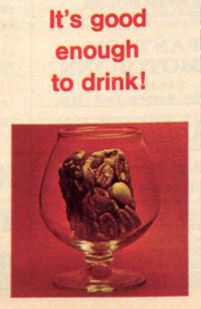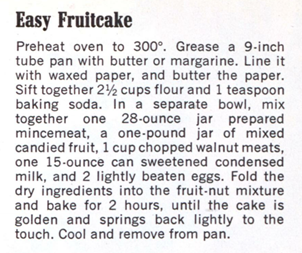The Dreaded Fruitcake Is Ripe for a Revival
Somewhere along the line, fruitcake lore took a terrible turn. One hundred years ago, soldiers overseas spoke fondly of receiving (and devouring) fruitcakes, hostesses were sure to whip them up for Christmas parties, and children anticipated their sweet arrival in winter months. In Truman Capote’s story “A Christmas Memory,” preparing a fruitcake is a beloved ritual that creates a heartfelt bond between the young and the old. The holiday dessert was a seasonal treasure, a spiced, sugary treat with booze. What’s not to love?
Sometime in the ’60s, an unfortunate fate met the fruitcake. It became a laughingstock, then it went away.
I grew up without ever tasting a fruitcake, but I heard all of the tired jokes about them (“they’re best used as doorstops,” “nutty as a fruitcake,” etc.). Most of the people I know have never tasted one either, but they all presume that it must taste terrible. I was skeptical that any dessert could be inherently bad, so I made one.

The fall of the fruitcake is a familiar story of commercialization gone wrong. Mass-produced versions of the confection proliferated in the mid-century, and these mail-order monstrosities earned a reputation of being thoughtless, last-minute gifts. The nutty block that arrived on the doorsteps of hapless recipients became known as a Christmas curse from some out-of-touch aunt who didn’t know any better. Since they were preserved with sugar and — sometimes — alcohol, they could last for years and even be regifted, leading Johnny Carson to famously quip that there is only one fruitcake in the world that people keep sending each other year after year.
In the ’70s, Butterfield Farms’ fruitcakes could be purchased from the pages of this magazine for “$5.95 plus $1.25 for postage and handling.” They were made with bourbon, brandy, and rum, and therefore “good enough to drink!” While you can no longer buy these particular fruitcakes (and at such a bargain!), I have a feeling there are a few of them somewhere that have outlived their poor caretakers.
With my own creation, I would set out to prove — at least to my friends and coworkers — that the fruitcake didn’t have to be a mailable holiday hex from Krampus himself. At the very least, I could nip on some rum and use up my roommates’ old raisins while watching Judy Garland’s 1963 Christmas special twice back-to-back.
 In choosing a recipe, I sought one that would summon the holiday spirit of yore without being too old-fashioned. A 1970 child’s recipe from Jack and Jill magazine that calls for a 28-ounce jar of mincemeat was absolutely out of the question. There was Mary Berry’s classic fruitcake, but the Great British Baking Show legend called for some obscure ingredients, like sultanas and black treacle, that I wasn’t prepared to track down. Other, more modern takes on fruitcake (like the Guiness Fruitcake and the Brandied Cherry Chocolate Cake) seemed delightful, but less traditional than I had in mind. I settled on Everyone’s Favorite Fruitcake from King Arthur Flour. With molasses, apricots, dates, and crystallized ginger, it’s a nice, bold return to the fruitcake’s glory years that doesn’t require more than one grocery stop.
In choosing a recipe, I sought one that would summon the holiday spirit of yore without being too old-fashioned. A 1970 child’s recipe from Jack and Jill magazine that calls for a 28-ounce jar of mincemeat was absolutely out of the question. There was Mary Berry’s classic fruitcake, but the Great British Baking Show legend called for some obscure ingredients, like sultanas and black treacle, that I wasn’t prepared to track down. Other, more modern takes on fruitcake (like the Guiness Fruitcake and the Brandied Cherry Chocolate Cake) seemed delightful, but less traditional than I had in mind. I settled on Everyone’s Favorite Fruitcake from King Arthur Flour. With molasses, apricots, dates, and crystallized ginger, it’s a nice, bold return to the fruitcake’s glory years that doesn’t require more than one grocery stop.
In my foray into fruitcake baking, I learned a few lessons:
- The ingredients are not cheap. Even if you go generic on the rum (like I did), dried fruits, molasses, nuts, and those spices that seem to disappear from your cabinet add up at the register.
- The process takes up a lot of time. First, you need to soak the fruit in rum overnight to do it right. Then, the bake takes hours at a cool 275-300 degrees. Finally, the cake should cool in its rum-glaze for at least a few hours before you dive in.
- No stand mixer? No problem. If your stand mixer budget went towards premium dried fruits and aged rum, don’t sweat it. The butter and dark brown sugar is better mixed by hand, and the rest of the mixing is no more than a light arm workout. Did Depression-era grannies use a Cuisinart for their creations?
I lugged my pride and joy into the office the next day along with a fifth of rum to ceremoniously “feed the cake.” If Johnny Carson was correct in saying only one fruitcake existed in the world, then now there were at least two. I ate a slice for breakfast and enjoyed it so much that I decided to have another after lunch. The second slice was a mistake, however, and it sat in my stomach like a rock. The heaviness of this fruitcake should not be underestimated. I asked for honest feedback on the fruitcake from coworkers, and one told me “it’s not gross at all” and “it’s certainly better than what the stories say.” Like many of us, she had heard so many foreboding anecdotes about fruitcake that it was difficult to pinpoint from whence any of them originated.
That fruitcake should experience a comeback is a no-brainer to me. The cultural preference for bold flavors, like molasses and dark brown sugar, seems perfectly aligned, and dried fruit and nuts are staples for the trendy paleo crowd. Baking, and even “anxiety baking,” is experiencing immense popularity as people find it a stress-reducing way to experiment with newly available ingredients and connect to their heritage. With so many opportunities for experimentation and enhancement, the fruitcake could be the Instagramable and YouTubeable trend of 2019 (alas, it might be too late for this holiday season). Plus, if you make it right, you can actually get a buzz.